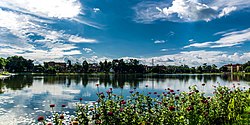
Back كوتش بيهار Arabic कूचबिहार Bihari কোচবিহার Bengali/Bangla কুচ বিহার BPY Cooch Behar Catalan Koch Bihār (lungsod) CEB Koch Bihar (Stadt) German Koch Bihar Spanish کوچ بهار Persian Cooch Behar Finnish
This article contains promotional content. (June 2024) |
Cooch Behar
Koch Bihar | |
|---|---|
City | |
Top: Cooch Behar Palace, bottom: Sadardighi Lake in 2013 | |
| Coordinates: 26°19′27.084″N 89°27′3.6″E / 26.32419000°N 89.451000°E | |
| Country | India |
| State | West Bengal |
| District | Cooch Behar |
| Government | |
| • Type | Municipality |
| • Body | Cooch Behar Municipality |
| • Chairman | Rabindra Nath Ghosh (All India Trinamool Congress) |
| Area | |
• Total | 8.29 km2 (3.20 sq mi) |
| Population (2011)[2] | |
• Total | 77,935 |
| • Density | 832/km2 (2,150/sq mi) |
| Languages | |
| • Official | Bengali[3][4] |
| • Additional official | English,[3] Rajbongshi[5] |
| • Regional | Bengali, Rajbongshi |
| Time zone | UTC+5:30 (IST) |
| PIN | 736101 |
| Telephone code | 03582 |
| Vehicle registration | WB-64/63 |
| Lok Sabha constituency | Cooch Behar (SC) |
| Vidhan Sabha constituency | Cooch Behar Uttar (SC), Cooch Behar Dakshin, Natabari |
| Website | coochbehar |

Cooch Behar (/ˌkuːtʃ bɪˈhɑːr/), or Koch Bihar, is a city and a municipality on the bank of River Torsa in the Indian state of West Bengal. It is the headquarters of the Cooch Behar district. It is in the foothills of the Eastern Himalayas at 26°22′N 89°29′E / 26.367°N 89.483°E. Cooch Behar is a planned city.[6] Being one of the main tourist destinations of West Bengal, housing the Cooch Behar Palace and Madan Mohan Temple, it has been declared a heritage city.[7] It is the maternal home of Gayatri Devi, the consort of the ruler of the former Jaipur State.
During the British Raj, Cooch Behar was the seat of the princely state of Koch Bihar, ruled by the Koch dynasty. On 20 August 1949, Cooch Behar District was transformed from a princely state to its present status, with the city of Cooch Behar as its headquarters.[8]
- ^ "Cooch Behar City". coochbeharmunicipality.com. Archived from the original on 15 February 2020. Retrieved 26 November 2020.
- ^ "Demography | Cooch Behar District | India". Retrieved 1 May 2023.
- ^ a b "Fact and Figures". wb.gov.in. Archived from the original on 14 June 2020. Retrieved 15 January 2019.
- ^ "52nd Report of the Commissioner for Linguistic Minorities in India" (PDF). nclm.nic.in. Ministry of Minority Affairs. p. 85. Archived from the original (PDF) on 25 May 2017. Retrieved 2 March 2019.
- ^ PTI (28 February 2018). "Kamtapuri, Rajbanshi make it to list of official languages in". India Today. Retrieved 11 October 2023.
- ^ "The Portal of North Bengal Development Department". Government of West Bengal. Retrieved 27 July 2023.
- ^ "Heritage Commission, West Bengal". wbhc.in. Archived from the original on 3 May 2023. Retrieved 1 May 2023.
- ^ "Brief Royal History of Cooch Behar 5". Archived from the original on 24 July 2011. Retrieved 22 October 2006.



